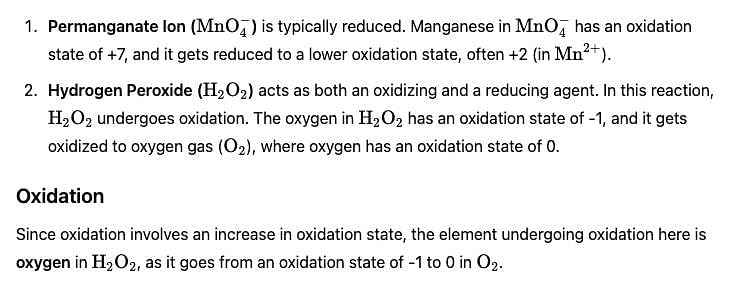JEE Exam > JEE Tests > Daily Test for JEE Preparation > Test: Redox Reactions in Terms of Electron Transfer Reactions (12 August) - JEE MCQ
Test: Redox Reactions in Terms of Electron Transfer Reactions (12 August) - JEE MCQ
Test Description
10 Questions MCQ Test Daily Test for JEE Preparation - Test: Redox Reactions in Terms of Electron Transfer Reactions (12 August)
Test: Redox Reactions in Terms of Electron Transfer Reactions (12 August) for JEE 2024 is part of Daily Test for JEE Preparation preparation. The Test: Redox Reactions in Terms of Electron Transfer Reactions (12 August) questions and answers have been
prepared according to the JEE exam syllabus.The Test: Redox Reactions in Terms of Electron Transfer Reactions (12 August) MCQs are made for JEE 2024 Exam. Find important
definitions, questions, notes, meanings, examples, exercises, MCQs and online tests for Test: Redox Reactions in Terms of Electron Transfer Reactions (12 August) below.
Solutions of Test: Redox Reactions in Terms of Electron Transfer Reactions (12 August) questions in English are available as part of our Daily Test for JEE Preparation for JEE & Test: Redox Reactions in Terms of Electron Transfer Reactions (12 August) solutions in
Hindi for Daily Test for JEE Preparation course. Download more important topics, notes, lectures and mock
test series for JEE Exam by signing up for free. Attempt Test: Redox Reactions in Terms of Electron Transfer Reactions (12 August) | 10 questions in 20 minutes | Mock test for JEE preparation | Free important questions MCQ to study Daily Test for JEE Preparation for JEE Exam | Download free PDF with solutions
Test: Redox Reactions in Terms of Electron Transfer Reactions (12 August) - Question 1
What is the oxidation half reaction of Cu+2 + Zn → Cu + Zn+2?
Detailed Solution for Test: Redox Reactions in Terms of Electron Transfer Reactions (12 August) - Question 1
Test: Redox Reactions in Terms of Electron Transfer Reactions (12 August) - Question 2
When a zinc rod is kept in a copper nitrate solution what happens?
Detailed Solution for Test: Redox Reactions in Terms of Electron Transfer Reactions (12 August) - Question 2
| 1 Crore+ students have signed up on EduRev. Have you? Download the App |
Test: Redox Reactions in Terms of Electron Transfer Reactions (12 August) - Question 3
In this reaction Cu+2 + Zn → Cu + Zn+2, what is an oxidising agent?
Detailed Solution for Test: Redox Reactions in Terms of Electron Transfer Reactions (12 August) - Question 3
Test: Redox Reactions in Terms of Electron Transfer Reactions (12 August) - Question 4
Loss of electrons is _________________
Detailed Solution for Test: Redox Reactions in Terms of Electron Transfer Reactions (12 August) - Question 4
Test: Redox Reactions in Terms of Electron Transfer Reactions (12 August) - Question 5
Which of the following is true as per the metal activity series?
Detailed Solution for Test: Redox Reactions in Terms of Electron Transfer Reactions (12 August) - Question 5
Test: Redox Reactions in Terms of Electron Transfer Reactions (12 August) - Question 6
Intensity of blue color increases gradually when _________________
Detailed Solution for Test: Redox Reactions in Terms of Electron Transfer Reactions (12 August) - Question 6
Test: Redox Reactions in Terms of Electron Transfer Reactions (12 August) - Question 7
What is a reducing agent of the reaction Cu+2 + Zn → Cu + Zn+2?
Detailed Solution for Test: Redox Reactions in Terms of Electron Transfer Reactions (12 August) - Question 7
Test: Redox Reactions in Terms of Electron Transfer Reactions (12 August) - Question 8
Which of the following is not an oxidising agent?
Detailed Solution for Test: Redox Reactions in Terms of Electron Transfer Reactions (12 August) - Question 8
Test: Redox Reactions in Terms of Electron Transfer Reactions (12 August) - Question 9
Hydrogen peroxide is a ______________
Detailed Solution for Test: Redox Reactions in Terms of Electron Transfer Reactions (12 August) - Question 9
Test: Redox Reactions in Terms of Electron Transfer Reactions (12 August) - Question 10
In the reaction between potassium permanganate (KMnO4) and hydrogen peroxide (H2O2) in an acidic medium, which element undergoes oxidation?
Detailed Solution for Test: Redox Reactions in Terms of Electron Transfer Reactions (12 August) - Question 10
|
360 tests
|
Information about Test: Redox Reactions in Terms of Electron Transfer Reactions (12 August) Page
In this test you can find the Exam questions for Test: Redox Reactions in Terms of Electron Transfer Reactions (12 August) solved & explained in the simplest way possible.
Besides giving Questions and answers for Test: Redox Reactions in Terms of Electron Transfer Reactions (12 August), EduRev gives you an ample number of Online tests for practice


















